What'sNEW Jul - Sep 2024
We raise the possibility that ...the broad pace of evolution on Earth is set by global environmental processes operating on geologic timescales (i.e., billions of years). This sounds like Gaia.

 "A reassessment of the 'hard-steps' model for the evolution of intelligent life," by Daniel B. Mills et al, arXiv:2408.10293 [q-bio.PE], 19 Aug 2025; and commentary: "A reassessment of the 'hard-steps' model for the evolution of intelligent life," by Daniel B. Mills et al, arXiv:2408.10293 [q-bio.PE], 19 Aug 2025; and commentary:
 "Can the 'hard steps' in the evolutionary history of human intelligence be recast with geological thresholds?" by David Appell, PhysOrg, 25 Sep 2024. "Can the 'hard steps' in the evolutionary history of human intelligence be recast with geological thresholds?" by David Appell, PhysOrg, 25 Sep 2024.
 Gaia has more about global environmental processes. Gaia has more about global environmental processes.
| 24 Sep 2024 |
What'sNEW about HGT


|
 ...17.5% of tardigrade genes were gained by horizontal gene transfer (HGT).
...17.5% of tardigrade genes were gained by horizontal gene transfer (HGT).
 "Antioxidant Defense in the Toughest Animals on the Earth: Its Contribution to the Extreme Resistance of Tardigrades," by Izabela Sadowska-Bartosz and Grzegorz Bartosz, Int J Mol Sci, Aug 2024. "Antioxidant Defense in the Toughest Animals on the Earth: Its Contribution to the Extreme Resistance of Tardigrades," by Izabela Sadowska-Bartosz and Grzegorz Bartosz, Int J Mol Sci, Aug 2024.
 Thanks Google Alerts. Thanks Google Alerts.
 25 May 2021: More about tardigrades. 25 May 2021: More about tardigrades.
 Viruses... has lots about HGT. Viruses... has lots about HGT.
 "Ice Skater: Beneath Europa s icy crust is a salty ocean, perhaps the best place in the Solar System to look for life," by Robin George Andrews, Science, 19 Sep 2024. "Ice Skater: Beneath Europa s icy crust is a salty ocean, perhaps the best place in the Solar System to look for life," by Robin George Andrews, Science, 19 Sep 2024.
 Life on Europa... has many related liks. Life on Europa... has many related liks.
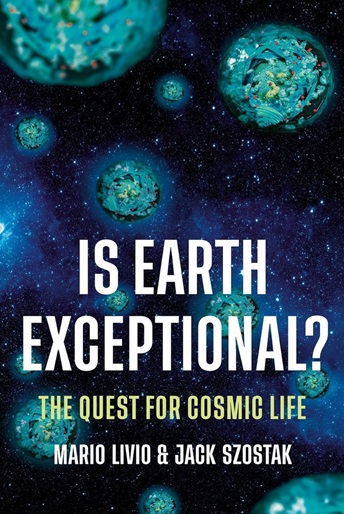 Is Earth Exceptional? That's the title question of a new book about the origin-of-life and the search for extraterrestrial life. Nobelist, biochemist and coauthor Jack Szostak's knowledge of origin of life is unsurpassed and his chemical analysis is the deepest you'll find. He stresses the need for tiny lipid containers to protect the precarious chemistry they would contain (and doubts that they could persist near ocean vents.) Still, there is lots of speculation and many unanswered questions, all related to the hardware problem. The equally difficult software problem — where does genetic programming come from? — is unaddressed, as usual.
Is Earth Exceptional? That's the title question of a new book about the origin-of-life and the search for extraterrestrial life. Nobelist, biochemist and coauthor Jack Szostak's knowledge of origin of life is unsurpassed and his chemical analysis is the deepest you'll find. He stresses the need for tiny lipid containers to protect the precarious chemistry they would contain (and doubts that they could persist near ocean vents.) Still, there is lots of speculation and many unanswered questions, all related to the hardware problem. The equally difficult software problem — where does genetic programming come from? — is unaddressed, as usual.
For extraterrestrial life, astrophysicist, science writer and coauthor Mario Livio gives a fair-minded and thorough review. He focusses on geochemistry and planetary histories, and his skepticism about Viking and ALH84001 includes insights from both sides. He favors robots over manned planetary missions, but shows no awareness of the crinoid fossil photographed by the Opportunity Mars rover. Both authors treat panspermia as an interesting distraction.
The book is extremely well researched, has plenty to teach and is easy to read. But let me comment on the optimistic origin-of-life message. While well-funded research continues, the gap between what is observed about the workings of cellular life and what can be explained by mainstream neo-Darwinian science continually grows. The conviction that life must originate is almost never recognized for what it is — an unexamined assumption. Meanwhile, all of the direct evidence says that life comes only from life. Since that is so, the assertion that life can originate actually constitutes an extraordinary claim. By Carl Sagan's dictum, there should be extraordinary evidence.
If we admit the possibility of life with no origin, other questions can be fruitfully explored.
 Is Earth Exceptional?: The Quest for Cosmic Life, by Mario Livio and Jack Szostak, Basic Books, 10 Sep 2024. Is Earth Exceptional?: The Quest for Cosmic Life, by Mario Livio and Jack Szostak, Basic Books, 10 Sep 2024.
 The RNA World and Other Origin-of-Life Theories has history and updates. The RNA World and Other Origin-of-Life Theories has history and updates.
 Robust Software Management illustrates the growing gap between what's observed and what's explained. Robust Software Management illustrates the growing gap between what's observed and what's explained.
 The Beginning has discussion about life with no origin. The Beginning has discussion about life with no origin.
How did eukaryotic cells evolve? Six Dutch microbiologists and theoretical biologists have reviewed this subject to summarize the latest research. As traditional neo-darwinists they want to rescue the tree-of-life, but most eukaryotic genes are seen to be acquired non-vertically — by various forms of HGT, or by endosymbiosis (red vertical line in graph) and afterward, when mitochondria lost genes to the eukaryotic nucleus. Among eukaryotic genes, only duplicated ones (blue) conform to neo-darwinian philosophy, and they are only "sometines associated with genetic novelty." Fourth among the illustrated mechanisms (yellow), "Truly novel eukaryotic genes that originated de novo through gene genesis from non-coding DNA are arguably the most enigmatic." The review has helpful illustrations, a Glossary and 169 references. Here are the mentioned graph and caption:
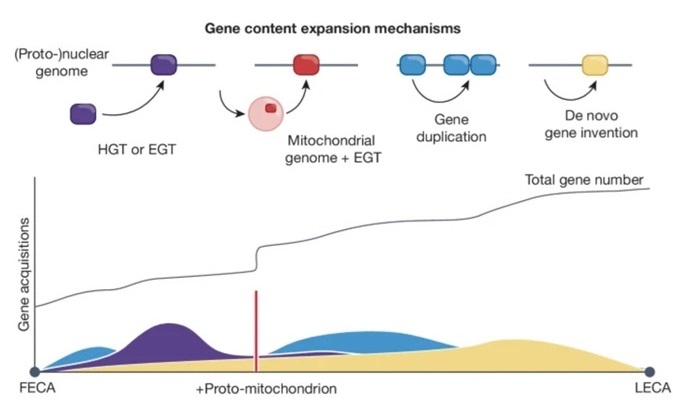 The relative contribution and timing of different mechanisms that expanded the genome between FECA and LECA are illustrated, loosely based on the branch length-based estimates from single gene trees. They comprise the contributions to both the nuclear and mitochondrial genomes. The red bar indicates the gain of proto-mitochondrial genes upon endosymbiosis. The timing estimates of de novo gene inventions correspond to a minimal estimate of their age based on the earliest duplications they underwent. The black line illustrates the total number of genes in the composite genome, including only those genes that were still present in LECA. The loss of proto-mitochondrial and FECA genes before LECA cannot be timed. EGT, endosymbiotic gene transfer; HGT, horizontal gene transfer.
The relative contribution and timing of different mechanisms that expanded the genome between FECA and LECA are illustrated, loosely based on the branch length-based estimates from single gene trees. They comprise the contributions to both the nuclear and mitochondrial genomes. The red bar indicates the gain of proto-mitochondrial genes upon endosymbiosis. The timing estimates of de novo gene inventions correspond to a minimal estimate of their age based on the earliest duplications they underwent. The black line illustrates the total number of genes in the composite genome, including only those genes that were still present in LECA. The loss of proto-mitochondrial and FECA genes before LECA cannot be timed. EGT, endosymbiotic gene transfer; HGT, horizontal gene transfer.
To comment: the evidence shows that eukaryogenesis relies heavily on transferred genes. The de novo ones also likely came by transfer (what else?) How genes transferred from prokaryotes or viruses acquired their eukaryotic programming is a huge, unanswered question. The puzzle is at least equal for evolution strictly among prokaryotes, where the reliance on transfer is seen to be complete. None of it makes neo-darwinian sense. A radical rethink is needed.
 "The emerging view on the origin and early evolution of eukaryotic cells," by Vosseberg, J., van Hooff, J.J.E., Köstlbacher, S. et al, doi:10.1038/s41586-024-07677-6, Nature, 11 Sep 2024.
Truly novel eukaryotic genes that originated de novo through gene genesis from non-coding DNA are arguably the most enigmatic. Previous work indicated that a substantial fraction... do not exhibit discernible homology to prokaryotic sequences. "The emerging view on the origin and early evolution of eukaryotic cells," by Vosseberg, J., van Hooff, J.J.E., Köstlbacher, S. et al, doi:10.1038/s41586-024-07677-6, Nature, 11 Sep 2024.
Truly novel eukaryotic genes that originated de novo through gene genesis from non-coding DNA are arguably the most enigmatic. Previous work indicated that a substantial fraction... do not exhibit discernible homology to prokaryotic sequences.
 ...De Novo Genes has updates for this subject. ...De Novo Genes has updates for this subject.
 07 May 2015: example ef Eukaryotic signature proteins (ESPs) in archaea. 07 May 2015: example ef Eukaryotic signature proteins (ESPs) in archaea.
 10 Mar 2021: New genes can be acquired only via HGT among prokaryotes: analysis, links and updates. 10 Mar 2021: New genes can be acquired only via HGT among prokaryotes: analysis, links and updates.
 Testing Darwinism versus Cosmic Ancestry, first posted 2002, has relevant discussion, Testing Darwinism versus Cosmic Ancestry, first posted 2002, has relevant discussion,
 NASA okays mission to search for life on Jupiter's moon Europa, by Michael Greshko, Nature, 10 Sep 2024. NASA okays mission to search for life on Jupiter's moon Europa, by Michael Greshko, Nature, 10 Sep 2024.
 "...NASA Mission Looked Doomed. Could Engineers Save It?" by David W. Brown, The New York Times, 17 Sep 2024. "...NASA Mission Looked Doomed. Could Engineers Save It?" by David W. Brown, The New York Times, 17 Sep 2024.
 Life on Europa, Other Moons, Other Planets?... has related links. Life on Europa, Other Moons, Other Planets?... has related links.
Chandra Wickramasinghe reviews the case for panspermia.
 Photographic Evidence of Panspermia: 30-minute interview by Brian Cory Dobbs, YouTube, 24 Aug 2024. Photographic Evidence of Panspermia: 30-minute interview by Brian Cory Dobbs, YouTube, 24 Aug 2024.
 ...Analysis of Interstellar Dust and ...Analysis of Interstellar Dust and  Chandra Wickramasinghe have background. Chandra Wickramasinghe have background.
| 23 Aug 2024 |
 earlier -
about Polonnaruwa earlier -
about Polonnaruwa
|
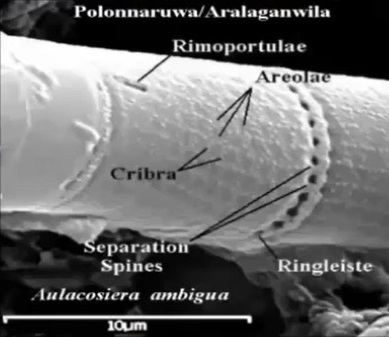 ...we concluded that this supported the concept of a cosmic microbiological system in which diatoms or similar microorganisms might exist on comets, Europa or in interstellar dust. So says Richard Hoover in a wide-ranging, illustrated talk about his astrobiology research. He pays special attention to the microscopic fossils in the Polonnaruwa meteorite (also designated Aralaganwila) that fell in Sri Lanka in 2012 (diatom fossil detail, right).
...we concluded that this supported the concept of a cosmic microbiological system in which diatoms or similar microorganisms might exist on comets, Europa or in interstellar dust. So says Richard Hoover in a wide-ranging, illustrated talk about his astrobiology research. He pays special attention to the microscopic fossils in the Polonnaruwa meteorite (also designated Aralaganwila) that fell in Sri Lanka in 2012 (diatom fossil detail, right).
 Astrobiology: Biomolecules and Life on Earth and in Icy Moons, Comets and Asteroids: 100-minute lecture by Richard B. Hoover for Eco Astronomy, Sri Lanka, 18 Aug 2024, on YouTube. Astrobiology: Biomolecules and Life on Earth and in Icy Moons, Comets and Asteroids: 100-minute lecture by Richard B. Hoover for Eco Astronomy, Sri Lanka, 18 Aug 2024, on YouTube.
 11 Jan 2013: A carbonaceous meteorite that fell in Sri Lanka..., with links to followup research and reactions. 11 Jan 2013: A carbonaceous meteorite that fell in Sri Lanka..., with links to followup research and reactions.
 Richard Hoover: collected articles. Richard Hoover: collected articles.
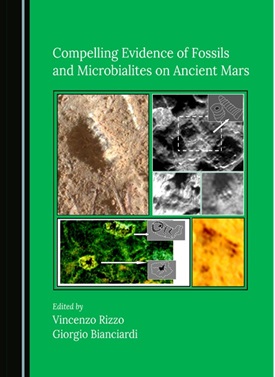 The data presented in this book support the existence of several types of organisms in the early life on Mars, especially microorganisms such as cyanobacteria, algae, possible lichens, fungi and other fossils of unclear attribution....
Vincenzo Rizzo of the National Research Center in Cosenza, Italy, and Giorgio Bianciardi, Department of Medical Biotechnology, University of Siena, Italy, offer a careful new examination of the evidence for past life on Mars. It includes worthwhile reviews of evidence from Viking, Mars meteorites and more. An extensive bibliography follows each of the four chapters,
The data presented in this book support the existence of several types of organisms in the early life on Mars, especially microorganisms such as cyanobacteria, algae, possible lichens, fungi and other fossils of unclear attribution....
Vincenzo Rizzo of the National Research Center in Cosenza, Italy, and Giorgio Bianciardi, Department of Medical Biotechnology, University of Siena, Italy, offer a careful new examination of the evidence for past life on Mars. It includes worthwhile reviews of evidence from Viking, Mars meteorites and more. An extensive bibliography follows each of the four chapters,
The heart of the book is its expert study of more than a hundred images from four Mars rovers, Opportunity, Spirit, Phoenix and Curiosity. Forms that, on Earth, would certainly be recognized as stromatolites, get careful scrutiny and reasoned argument. Various other forms of microbial life are also convincingly visualized in the Mars images, with helpful comments. The discussion of bluberries and "newberries" is unconventional and enlightening.
Skeptics will likely compare some of their suggestions to the supposed canals on Mars, first claimed by Giovanni Schiaparelli and later championed by Percival Lowell. That would ignore the quantitative and statistical analysis also provided. The subject deserves to be considered by the broadest range of experts, especially sedimentologists, with open minds and genuine curiosity. This book is an excellent new resource for the question of past life on Mars.
 Compelling Evidence of Fossils and Microbialites on Ancient Mars, edited by Vincenzo Rizzo and Giorgio Bianciardi, [poster], ISBN:978-1-0364-0827-5, Cambridge Scholars Publishing, 25 Jul 2024. Compelling Evidence of Fossils and Microbialites on Ancient Mars, edited by Vincenzo Rizzo and Giorgio Bianciardi, [poster], ISBN:978-1-0364-0827-5, Cambridge Scholars Publishing, 25 Jul 2024.
 Thanks for an advance copy, coeditor Vincenzo Rizzo, and Tim Harvey of Cambridge Scholars Publishing. Thanks for an advance copy, coeditor Vincenzo Rizzo, and Tim Harvey of Cambridge Scholars Publishing.
 "Why should geological criteria used on Earth not be valid also for Mars? Evidence of possible microbialites and algae in extinct Martian lakes," by Vincenzo Rizzo, International Journal of Astrobiology, 02 Mar 2020. "Why should geological criteria used on Earth not be valid also for Mars? Evidence of possible microbialites and algae in extinct Martian lakes," by Vincenzo Rizzo, International Journal of Astrobiology, 02 Mar 2020.
 "The Case for Past Life on Mars Gets Stronger," by Dirk Schulze-Makuch, Smithsonian Magazine, 13 Apr 2020. "The Case for Past Life on Mars Gets Stronger," by Dirk Schulze-Makuch, Smithsonian Magazine, 13 Apr 2020.
 Life on Mars! has history and updates. Life on Mars! has history and updates.
 Autotrophic Microbes on Mars: Steven Benner in a 2-hour interview with Brian Cory Dobbs, posted 17 Aug 2024. Informative, entertaining and inconclusive. (What is NASA's "Standards Committee?" Oh, it's this paper:) Autotrophic Microbes on Mars: Steven Benner in a 2-hour interview with Brian Cory Dobbs, posted 17 Aug 2024. Informative, entertaining and inconclusive. (What is NASA's "Standards Committee?" Oh, it's this paper:)
 "Community Report from the Biosignatures Standards of Evidence Workshop" arXiv:2210.14293, Oct 2022. "Community Report from the Biosignatures Standards of Evidence Workshop" arXiv:2210.14293, Oct 2022.
 "Scientists find oceans of water on Mars. It's just too deep to tap." UC - Berkeley via PhysOrg; re: "Scientists find oceans of water on Mars. It's just too deep to tap." UC - Berkeley via PhysOrg; re:
 "Liquid water in the Martian mid-crust," by Vashan Wright et al, doi:10.1073/pnas.2409983121, PNAS, 12 Aug 2024. "Liquid water in the Martian mid-crust," by Vashan Wright et al, doi:10.1073/pnas.2409983121, PNAS, 12 Aug 2024.
 Life on Mars! has lots about water there, but this much buried water is a newsworthy. Life on Mars! has lots about water there, but this much buried water is a newsworthy.
 We now have a treasure trove of rocks that will let us systematically study the processes that people believe are relevant to the emergence of life on the planet. So says Frieder Klein, a member of the team extracting a 1268-meter core from below the floor of the deep ocean.
We now have a treasure trove of rocks that will let us systematically study the processes that people believe are relevant to the emergence of life on the planet. So says Frieder Klein, a member of the team extracting a 1268-meter core from below the floor of the deep ocean.
 "Ship Brings Rocky Clues to Life's Origins Up From Ocean's 'Lost City'," by William J. Broad, The New York Times, 08 Aug 2024; re: "Ship Brings Rocky Clues to Life's Origins Up From Ocean's 'Lost City'," by William J. Broad, The New York Times, 08 Aug 2024; re:
 "A long section of serpentinized depleted mantle peridotite," doi:10.1126/science.adp1058, by C. Johan Lissenberg et al, and perspective by Eric Hellebrand, Science, 08 Aug 2024. "A long section of serpentinized depleted mantle peridotite," doi:10.1126/science.adp1058, by C. Johan Lissenberg et al, and perspective by Eric Hellebrand, Science, 08 Aug 2024.
 "Recovery of rocks that originated in Earth's mantle could reveal secrets of planet's history," Woods Hole Oceanographic Institution via PhysOrg, 08 Aug 2024. "Recovery of rocks that originated in Earth's mantle could reveal secrets of planet's history," Woods Hole Oceanographic Institution via PhysOrg, 08 Aug 2024.
Retreiving the very long core sample was a remarkable achievement. The analysis conducted so far is impressive, and there is still much planetary science to learn from it. More speculation about the hardware aspect of the origin-of-life may also be spun out of it, but that's what gets public attention, apparently.
 The RNA World: and Other Origin-of-Life Theories has discussion and history. The RNA World: and Other Origin-of-Life Theories has discussion and history.
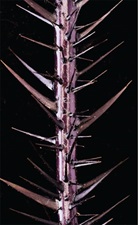 Our results show that, even over long evolutionary timescales, the same genetic components of a common developmental tool kit can be repeatedly co-opted to produce convergent phenotypes.
Our results show that, even over long evolutionary timescales, the same genetic components of a common developmental tool kit can be repeatedly co-opted to produce convergent phenotypes.
 "Convergent evolution of plant prickles by repeated gene co-option over deep time," by James W. Satterlee et al, doi:10.1126/science.ado1663; and commentary by Elizabeth A. Kellogg, Science, 02 Aug 2024. "Convergent evolution of plant prickles by repeated gene co-option over deep time," by James W. Satterlee et al, doi:10.1126/science.ado1663; and commentary by Elizabeth A. Kellogg, Science, 02 Aug 2024.
 "How Did Roses Get Their Thorns?" by Carl Zimmer, The New York Times, 01 Aug 2024.
Each time prickles [thorns] arose, plants did not evolve an entirely new way to make them. They just borrowed the same gene again and again. "How Did Roses Get Their Thorns?" by Carl Zimmer, The New York Times, 01 Aug 2024.
Each time prickles [thorns] arose, plants did not evolve an entirely new way to make them. They just borrowed the same gene again and again.
Convergent evolution puzzled Charles Darwin and remains puzzling. One simple explanation could be that, in each instance, the same genetic program is responsible for the phenomenon. A close analysis of the convergent evolution of thorns supports this suggestion.
 Convergent Evolution, a section of the "Neo-Darwinism..." webpage, has background. Convergent Evolution, a section of the "Neo-Darwinism..." webpage, has background.
 "Signs of two gases in clouds of Venus could indicate life...," by Hannah Devlin, The Guardian, 17 Jul 2024. "Signs of two gases in clouds of Venus could indicate life...," by Hannah Devlin, The Guardian, 17 Jul 2024.
 Thanks, Jim Powers. Thanks, Jim Powers.
 Life on Europa, Other Moons, Other Planets?... has related links. Search for Venus. Life on Europa, Other Moons, Other Planets?... has related links. Search for Venus.
NASA says that chemical and physical evidence points to ancient microbial life on Mars, and lobbies for a new way to bring samples back to Earth.
 "Perseverance rover discovers rock with potential signs of ancient life," NASA via PhysOrg, 25 Jul 2024. "Perseverance rover discovers rock with potential signs of ancient life," NASA via PhysOrg, 25 Jul 2024.
 "NASA ...Very Excited About This Rock," by Kenneth Chang, The New York Times, 25 Jul 2024. "NASA ...Very Excited About This Rock," by Kenneth Chang, The New York Times, 25 Jul 2024.
 Life on Mars! cites lots of existing evidence, beginning with Viking in 1976. Life on Mars! cites lots of existing evidence, beginning with Viking in 1976.
Something is pumping out large amounts of oxygen at the bottom of the Pacific Ocean, at depths where a total lack of sunlight makes photosynthesis impossible. Could this "dark oxygen production" (DOP) come from electrolysis, catalysed on the surfaces of mineral-rich nodules? That's the conjecture of an international interdisciplinary team who measured the oxygen accumuation and modelled the suggested process.
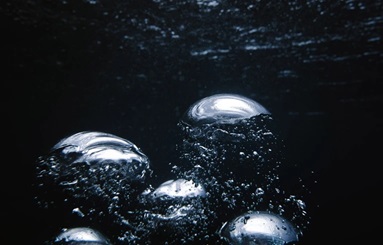
 "Evidence of dark oxygen production at the abyssal seafloor," by Sweetman, A.K., Smith, A.J., de Jonge, D.S.W. et al, doi:10.1038/s41561-024-01480-8, [link], Nat. Geosci., 22 Jul 2024; and commentary: "Evidence of dark oxygen production at the abyssal seafloor," by Sweetman, A.K., Smith, A.J., de Jonge, D.S.W. et al, doi:10.1038/s41561-024-01480-8, [link], Nat. Geosci., 22 Jul 2024; and commentary:
 "Mystery oxygen source discovered on the sea floor – bewildering scientists," by Davide Castelvecchi, [link], Nature, 22 Jul 2024. "Mystery oxygen source discovered on the sea floor – bewildering scientists," by Davide Castelvecchi, [link], Nature, 22 Jul 2024.
 Thanks, Google Alerts.
However it is produced, if oxygen is available without light, it would permit oxygen-dependent metazoan life to live in the dark, ice-covered oceans of bodies like Europa. Thanks, Google Alerts.
However it is produced, if oxygen is available without light, it would permit oxygen-dependent metazoan life to live in the dark, ice-covered oceans of bodies like Europa.
 Life on Europa, Other Moons, Other Planets? has more about ice-covered oceans. Life on Europa, Other Moons, Other Planets? has more about ice-covered oceans.
 21 Jul 2023: another study suggests that oxygen can accumulate without photosynthesis. 21 Jul 2023: another study suggests that oxygen can accumulate without photosynthesis.
  "Claim of 'dark oxygen on sea floor faces doubts," by Paul Voosen, Sciencce, 10 Sep 2024. "Claim of 'dark oxygen on sea floor faces doubts," by Paul Voosen, Sciencce, 10 Sep 2024.
| 22 Jul 2024 |
What'sNEW about HGT


|
...an exciting example of foreign genes functioning in animal genomes.
 "Bdelloid rotifers deploy horizontally acquired biosynthetic genes against a fungal pathogen," by Nowell, R.W., Rodriguez, F., Hecox-Lea, B.J. et al, doi:10.1038/s41467-024-49919-1, Nat Commun, 18 Jul 2024. "Bdelloid rotifers deploy horizontally acquired biosynthetic genes against a fungal pathogen," by Nowell, R.W., Rodriguez, F., Hecox-Lea, B.J. et al, doi:10.1038/s41467-024-49919-1, Nat Commun, 18 Jul 2024.
 "Small animals acquire genes from bacteria that can produce antibiotics," Marine Biological Laboratory via EurekAlert!, 18 Jul 2024. "Small animals acquire genes from bacteria that can produce antibiotics," Marine Biological Laboratory via EurekAlert!, 18 Jul 2024.
 "These microscopic animals fight off infection using genes 'stolen' from bacteria," Science, 18 Jul 2024. "These microscopic animals fight off infection using genes 'stolen' from bacteria," Science, 18 Jul 2024.
 Viruses and Other Gene Transfer Mechanisms has links to hundreds of examples of HGT.
... these data suggest that cross-kingdom HGT events shape the metabolic capabilities and interactions between plants and bacteria. Viruses and Other Gene Transfer Mechanisms has links to hundreds of examples of HGT.
... these data suggest that cross-kingdom HGT events shape the metabolic capabilities and interactions between plants and bacteria.
 "Widespread horizontal gene transfer between plants and bacteria," ISME Communicatins, 01 Jan 2024. "Widespread horizontal gene transfer between plants and bacteria," ISME Communicatins, 01 Jan 2024.
 Thanks, Google Alerts. Thanks, Google Alerts.
...one of the most promising habitable zone exoplanet candidates known, 48 lightyears away, is seen with the Webb Space Telescope. Larger than Earth, in the "Goldilocks Zone" of a red dwarf star, its density suggests it is 10 to 20 percent water. If so, it likely harbors an ice-covered ocean, and, if tidally locked, its sunny side could even have open water. Might it resemble an eyeball?!
 "Found with Webb: a potentially habitable world," University of Montreal +PhysOrg, 08 Jul 2024; re: "Found with Webb: a potentially habitable world," University of Montreal +PhysOrg, 08 Jul 2024; re:
 "Transmission Spectroscopy of the Habitable Zone Exoplanet LHS 1140 b with JWST/NIRISS," by Charles Cadieux et al, arXiv:2406.15136 [astro-ph.EP] 21 Jun 2024. "Transmission Spectroscopy of the Habitable Zone Exoplanet LHS 1140 b with JWST/NIRISS," by Charles Cadieux et al, arXiv:2406.15136 [astro-ph.EP] 21 Jun 2024.
 Life on Europa, Other Moons, Other Planets? has related links. Life on Europa, Other Moons, Other Planets? has related links.
| 07 Jul 2024 |
What'sNEW about HGT


|
 Overall, Mycena show highly unusual, varied mosaic-like genomic structures adaptable to multiple lifestyles, providing genomic illustration for the growing realization that fungal niche adaptations can be far more fluid than traditionally believed.
Overall, Mycena show highly unusual, varied mosaic-like genomic structures adaptable to multiple lifestyles, providing genomic illustration for the growing realization that fungal niche adaptations can be far more fluid than traditionally believed.
An international team has sequenced the genomes of 24 species of "bonnet" mushrooms as part of the 1000 Fungal Genomes project. They found that the genomes of three Arctic ones were especially large. Gene duplications, TE insertions, HGT, de novo and orphan genes all apparently contributed to the genome expansions. Many of the extra genes, although conserved across several species, are silent, and most of them are unrecognized. To explain these surprises, new corrolaries to neo-Darwinian theory are considered.
 "Extreme overall mushroom genome expansion in Mycena s.s. irrespective of plant hosts or substrate specializations," by Christoffer Bugge Harder et al, doi:10.1016/j.xgen.2024.100586, Cell Genomics, 27 Jun 2024. "Extreme overall mushroom genome expansion in Mycena s.s. irrespective of plant hosts or substrate specializations," by Christoffer Bugge Harder et al, doi:10.1016/j.xgen.2024.100586, Cell Genomics, 27 Jun 2024.
 "Genetic Giants: Unveiling the Massive Genomes of Arctic's Glow-in-the-Dark Mushrooms," SciTechDaily, 27 Jun 2024. "Genetic Giants: Unveiling the Massive Genomes of Arctic's Glow-in-the-Dark Mushrooms," SciTechDaily, 27 Jun 2024.
In cosmic ancestry, unnecesary genes, genes-in-waiting, unfamiliar, orphan and de novo genes are expected. Evolution can make significant steps when robust software management "tinkers" with existing, available programming such as that. This latter suggestion even gets inferential support in the new study: TE insertions were seen to be especially active around transcription factors, which can turn genes on-or-off. The study is comprehensive and deep.
 Viruses and Other Gene Transfer Mechanisms has lots about HGT. Viruses and Other Gene Transfer Mechanisms has lots about HGT.
 Robust Software Management introduces this concept and the need for it. Robust Software Management introduces this concept and the need for it.
The history of life on Earth is the his tory of life's remaking Earth.
 "The Mysterious, Deep-Dwelling Microbes That Sculpt Our Planet," by Ferris Jabr, The New York Times, 24 Jun 2024. "The Mysterious, Deep-Dwelling Microbes That Sculpt Our Planet," by Ferris Jabr, The New York Times, 24 Jun 2024.
 Gaia and James Lovelock are well endorsed by Jabr. Gaia and James Lovelock are well endorsed by Jabr.
 Bacteria... discusses their surprising range and engineering capability.. Bacteria... discusses their surprising range and engineering capability..
On Earth, dimethylsulfide (DMS) is produced exclusively by biological metabolism. That's why Carl Sagan thought it might be a good "biomarker" — if seen in an extraterrestrial environment, a positive sign that biology exists there. Now its presence on comet 67P/Churyumov-Gerasimenko has been confirmed, after two years of close inspection with a high-resolution mass spectrometer aboard the Rosetta spacecraft. This detection was the subject of a paper by five astrobiologists in a session titled, "Rocky planets, moons, and minor bodies: Evolution, characterization and astrobiological implications," at a recent conference of the European Geophysical Union (EGU), in Vienna, Austria.

 "Is dimethylsulfide a good biomarker?" by Nora Hänni et al. [abstract], EGU General Assembly 2024, 14-19 Apr 2024. "Is dimethylsulfide a good biomarker?" by Nora Hänni et al. [abstract], EGU General Assembly 2024, 14-19 Apr 2024.
 Thanks, Richard B. Hoover. Thanks, Richard B. Hoover.
Their reaction leaves me dumbfounded. Before the evience is in, they already know where life is and isn't: But what if this biomarker is present in the completely abiotic cometary matter? ...Our detailed analysis of the sulfur-bearing hydrocarbon signals detectable in 67P's coma yields strong evidence for the presence of DMS and thus provides the basis to argue that this molecule might not be a robust indicator of extraterrestrial life.
 12 Sep 2023: Another detection of extraterrestrial DMS. 12 Sep 2023: Another detection of extraterrestrial DMS.
 03 Oct 2017: A different biomarker is seen (also on 67P) and then delisted. 03 Oct 2017: A different biomarker is seen (also on 67P) and then delisted.
![]()
|

 ...17.5% of tardigrade genes were gained by horizontal gene transfer (HGT).
...17.5% of tardigrade genes were gained by horizontal gene transfer (HGT).
 Is Earth Exceptional? That's the title question of a new book about the origin-of-life and the search for extraterrestrial life. Nobelist, biochemist and coauthor Jack Szostak's knowledge of origin of life is unsurpassed and his chemical analysis is the deepest you'll find. He stresses the need for tiny lipid containers to protect the precarious chemistry they would contain (and doubts that they could persist near ocean vents.) Still, there is lots of speculation and many unanswered questions, all related to the hardware problem. The equally difficult software problem — where does genetic programming come from? — is unaddressed, as usual.
Is Earth Exceptional? That's the title question of a new book about the origin-of-life and the search for extraterrestrial life. Nobelist, biochemist and coauthor Jack Szostak's knowledge of origin of life is unsurpassed and his chemical analysis is the deepest you'll find. He stresses the need for tiny lipid containers to protect the precarious chemistry they would contain (and doubts that they could persist near ocean vents.) Still, there is lots of speculation and many unanswered questions, all related to the hardware problem. The equally difficult software problem — where does genetic programming come from? — is unaddressed, as usual.
 ...we concluded that this supported the concept of a cosmic microbiological system in which diatoms or similar microorganisms might exist on comets, Europa or in interstellar dust. So says Richard Hoover in a wide-ranging, illustrated talk about his astrobiology research. He pays special attention to the microscopic fossils in the Polonnaruwa meteorite (also designated Aralaganwila) that fell in Sri Lanka in 2012 (diatom fossil detail, right).
...we concluded that this supported the concept of a cosmic microbiological system in which diatoms or similar microorganisms might exist on comets, Europa or in interstellar dust. So says Richard Hoover in a wide-ranging, illustrated talk about his astrobiology research. He pays special attention to the microscopic fossils in the Polonnaruwa meteorite (also designated Aralaganwila) that fell in Sri Lanka in 2012 (diatom fossil detail, right).
 The data presented in this book support the existence of several types of organisms in the early life on Mars, especially microorganisms such as cyanobacteria, algae, possible lichens, fungi and other fossils of unclear attribution....
Vincenzo Rizzo of the National Research Center in Cosenza, Italy, and Giorgio Bianciardi, Department of Medical Biotechnology, University of Siena, Italy, offer a careful new examination of the evidence for past life on Mars. It includes worthwhile reviews of evidence from Viking, Mars meteorites and more. An extensive bibliography follows each of the four chapters,
The data presented in this book support the existence of several types of organisms in the early life on Mars, especially microorganisms such as cyanobacteria, algae, possible lichens, fungi and other fossils of unclear attribution....
Vincenzo Rizzo of the National Research Center in Cosenza, Italy, and Giorgio Bianciardi, Department of Medical Biotechnology, University of Siena, Italy, offer a careful new examination of the evidence for past life on Mars. It includes worthwhile reviews of evidence from Viking, Mars meteorites and more. An extensive bibliography follows each of the four chapters,

 Our results show that, even over long evolutionary timescales, the same genetic components of a common developmental tool kit can be repeatedly co-opted to produce convergent phenotypes.
Our results show that, even over long evolutionary timescales, the same genetic components of a common developmental tool kit can be repeatedly co-opted to produce convergent phenotypes.

 Overall, Mycena show highly unusual, varied mosaic-like genomic structures adaptable to multiple lifestyles, providing genomic illustration for the growing realization that fungal niche adaptations can be far more fluid than traditionally believed.
Overall, Mycena show highly unusual, varied mosaic-like genomic structures adaptable to multiple lifestyles, providing genomic illustration for the growing realization that fungal niche adaptations can be far more fluid than traditionally believed.

 The relative contribution and timing of different mechanisms that expanded the genome between FECA and LECA are illustrated, loosely based on the branch length-based estimates from single gene trees. They comprise the contributions to both the nuclear and mitochondrial genomes. The red bar indicates the gain of proto-mitochondrial genes upon endosymbiosis. The timing estimates of de novo gene inventions correspond to a minimal estimate of their age based on the earliest duplications they underwent. The black line illustrates the total number of genes in the composite genome, including only those genes that were still present in LECA. The loss of proto-mitochondrial and FECA genes before LECA cannot be timed. EGT, endosymbiotic gene transfer; HGT, horizontal gene transfer.
The relative contribution and timing of different mechanisms that expanded the genome between FECA and LECA are illustrated, loosely based on the branch length-based estimates from single gene trees. They comprise the contributions to both the nuclear and mitochondrial genomes. The red bar indicates the gain of proto-mitochondrial genes upon endosymbiosis. The timing estimates of de novo gene inventions correspond to a minimal estimate of their age based on the earliest duplications they underwent. The black line illustrates the total number of genes in the composite genome, including only those genes that were still present in LECA. The loss of proto-mitochondrial and FECA genes before LECA cannot be timed. EGT, endosymbiotic gene transfer; HGT, horizontal gene transfer.